As a "radical [Roman] traditionalist" I find it quite ironic that my first post has a distinctly ecumenical theme and perspective. I currently attend a Byzantine rite Catholic parish, specifically the Melkite church in Antioch, and went to my father confessor today to be absolved of my endless offences against the Lord. Afterward the priest, who for privacy will remain anonymous, and I discussed the relations between Eastern rite Catholics and the Orthodox churches. After poking some fun at archbishop
John Ireland he stated his belief that the schism between the Catholic Church and the various Eastern churches called Orthodox will only be healed "when the people in the pew stop caring" about the separation.
What did he mean by this? When Catholics and the Orthodox may communicate without hesitation at each other's Masses and Divine Liturgies, and partake of the other Sacraments, or Mysteries. The priest proceeded to tell me of one Melkite priest who semi-regularly concelebrates with a Orthodox priest, albeit illicitly. Similarly, he said, there are Orthodox priests who, when on vacation, attend and communicate at Roman rite Catholic Masses when there is no church from their Orthodox tradition available. This inevitably brings up the question: what are we to think of the schism that occurred in 1054 between the archbishop of Constantinople and the Bishop of Rome, the Pope? First, we should consider that the conventional narrative about the East-West schism is quite wrong.
The conventional narrative goes something like this: Ever since the Apostolic era, the five major bishops of the world (the "patriarchs") were considered quite equal in every way, although the bishop of Rome was seen as having some sort of honorary primacy. This status of church government remained throughout the first millennium until the Westerners, or Latins, began to fiddle with the Creed and the bishop of Rome began to get uppity in his claims to have total and complete authority over the entire Church. In a fit, he ex-communicated the archbishop of Constantinople, who, upholding the purer Eastern tradition would have none of this Papal nonsense, and who then ex-communicated the Pope back. And since 1054 the two sides have not spoken.
The real story is a bit more involved, and perhaps more revealing about the current state of affairs.
Fr. John Berg FSSP celebrates the old Roman Mass at St. Peter's tomb in the
Clementine Chapel of St. Peter's Basilica
The case for ancient Roman primacy among the bishops of Christendom is not a very difficult case to make, but defining it in specific terms is quite a challenge. Ss. Peter and Paul died in Rome during the 60s AD. I have been honored by Almighty God to stand at the tomb of the Apostle Peter under the high altar of St. Peter's Basilica. St. Peter clearly possessed some sort of great authority over the other Apostles, and was indeed the "rock" of the Church:
And Jesus came into the quarters of Caesarea Philippi: and he asked his disciples, saying: Whom do men say that the Son of man is? But they said: Some John the Baptist, and other some Elias, and others Jeremias, or one of the prophets. Jesus saith to them: But whom do you say that I am? Simon Peter answered and said: Thou art Christ, the Son of the living God. And Jesus answering, said to him: Blessed art thou, Simon Bar-Jona: because flesh and blood hath not revealed it to thee, but my Father who is in heaven. And I say to thee: That thou art Peter; and upon this rock I will build my church, and the gates of hell shall not prevail against it. And I will give to thee the keys of the kingdom of heaven. And whatsoever thou shalt bind upon earth, it shall be bound also in heaven: and whatsoever thou shalt loose upon earth, it shall be loosed also in heaven. Then he commanded his disciples, that they should tell no one that he was Jesus the Christ. —The Gospel According to St. Matthew 16:13-20
The Roman Church's closeness to the Prince of the Apostles and to St. Paul, the greatest preacher of the Gospel, would already give Rome a certain amount of prestige. In the second century St. Irenaeus, born in Asia Minor and eventually bishop of Lyon in Gaul, wrote:
Ad hanc enim ecclesiam propter potentiorem principalitatem necesse est omnem convenire ecclesiam, hoc est, eos qui sunt undique fideles, in qua semper ab his, qui sunt undique, conservata est ea quae est ab apostolis traditio. —Adversus Haereses, 3:2
or:
In fact, it is with this church, by reason of her more excellent origin, that every church must necessarily be in agreement—with this Church in which the tradition that comes from the apostles has always been preserved by everyone.
Certain proceeding events solidified the foundation for the Roman Church, and her bishop, to enjoy and exert power over the rest of Christendom in doctrinal and jurisdictional matters. The foremost of these was the Council of Chalcedon, which had been called to combat the monophysite heresy so popular in the far east to this day. Pope St. Leo the Great presided over the Council, but through a legate. The Pope, who only spoke Latin and knew no Greek, declined to make the journey from Rome. When Leo sent his analysis and opinion of the monophysite question to the Council, the Council concluded:
After the reading of the foregoing epistle, the most reverend bishops cried out: This is the faith of the fathers, this is the faith of the Apostles. So we all believe, thus the orthodox believe. Anathema to him who does not thus believe. Peter has spoken thus through Leo. So taught the Apostles. Piously and truly did Leo teach, so taught Cyril. Everlasting be the memory of Cyril. Leo and Cyril taught the same thing, anathema to him who does not so believe. This is the true faith. Those of us who are orthodox thus believe. This is the faith of the fathers. Why were not these things read at Ephesus [i.e. at the heretical synod held there]? These are the things Dioscorus hid away. —Labbe and Cossart, Concilia, tom. IV, col. 368
Chalcedon offered the Pope of Rome the title "universal bishop," not a small matter. In his humility, St. Leo declined its use. Similarly St. Gregory the Great, greatest of all Roman Pontiffs after Peter, only signed himself as "bishop" when addressing international clergy, but he certainly put a stop to contemporary attempts of John IV of Constantinople to style himself as "ecumenical patriarch."
St. Gregory the Great, Pope from 590-604 AD
The second major visible turn in favor of Roman primacy, in my opinion, was the deposition of Photios as archbishop of Constantinople. In 858 AD a bright scholar named Photios, at Emperor Michael's urging, was ordained subdeacon, deacon, priest, consecrated archbishop, and enthroned in the Hagia Sophia on successive days. There was one problem: there was already an archbishop of Constantinople, Ignatios. Pope St. Nicholas, the last Pope called "the Great," sided with the humble and holy Ignatios against Michael and Photios. Emperor Michael was assassinated and went to God's Judgment seat, effectively removing Photios from the Hagia Sophia and banishing him while the new emperor sought better relations with the Pope and the West. The patriarch Photios convened his own council—which no Orthodox church officially accepts, although some Greeks do give it their ascent—and ex-communicated Pope Nicholas on the grounds of heresy and condemned the new(ish) Creed in vogue in the West. Photios was condemned by the Fourth Council of Constantinople, which Catholics accept as the eighth Church council, and Ignatios was re-instated. Years later Photios found his way back to the bishopric of Constantinople. This was a great boon and proof to the claims of the Pope to having real, tangible jurisdiction throughout the Church, even in Constantinople.
Other issues pervaded. Popes, particularly St. Leo IX, often quoted the fictitious "Donation of Constantine" in their claims to temporal authority throughout the world. By far the most divisive issue was the Latin addition "filioque" to the Latin text of the Creed: "qui ex patre filioque procedit" as opposed to the earlier "qui ex patre procedit." Easterners rightfully said that this was not the text of the Creed appointed at the Nicene Council of the Council of Constantinople, which also forbade its alteration. This emendation, which arose either in the Iberian Peninsula or Persia and which traveled to Gaul, attempted to fight remnants of the Arian heresy, which denied Christ's divinity. This clause emphasizes, especially in Latin, the closeness in divinity between the Father and the Son. In Greek though, the word for "proceed" (in Latin "procedere," which means "proceed" as in English) προϊέναι means to emanate from a single source. Not only would this clause be heretical in Greek, it would be grammatically impossible.
The other major controversy was the Western tendency to use unleavened bread for the Eucharist.
Although the Synoptic accounts would seem to indicate the Last Supper utilized unleavened bread, the early Christians simply used whatever they had, almost always leavened bread. Easterners took this to be a major violation of Tradition, and possibly invalidating. The Papacy was an issue, but not the primary or secondary one.
In 1054 Pope St. Leo IX sent Cardinal Humbert to Constantinople after the patriarch Michael condemned the use of unleavened bread. The cardinal, who possessed legatine powers, caused a stir in the patriarchal palace and, although the Pope had died, ex-communicated Michael using his defunct-legatine powers. The patriarch reacted by denying Papal authority and ex-communicating the cardinal and the dead saint. Needless to say, when Paul VI and Athenagoras lifted the ex-communications of each other, they were engaging in a needless exercise, as the initial decrees had been invalid from their inception.
Paul VI and Athengoras in Rome during the
Second Vatican Council, c.1964
The Crusades, which had uniting potential, went quite awry when the Fourth Crusade, ignoring Pope Innocent III's strict instructions to avoid Constantinople, sacked the great Eastern city to pay war debts to the Doge of Venice (one Oratorian delightfully calls him the "dodgy Doge!"). No living person was raped, killed, or looted during that dark period in 1204, but the wounds still bleed to this day. The Eastern churches, not just Constantinople, legally reconciled, recognized Papal primacy, and the "filioque" (in the orthodox Latin and the doubtful Greek) twice, at the Council of Lyon and the Council of Florence, neither of which any Orthodox church now recognizes.
In the last council, at Florence, only one Eastern attendee, [St?] Mark of Ephesus, refused to sign the Council documents which provided the re-union, much sought by Rome for matters of faith and by Constantinople for matters of survival. Mark went as far to hold Rome and all of Western Christianity in schism and heresy. In the years after the Council the Pope was unable to keep peace in the midst of consolidating nations in Europe, much less provide protection from the ever-encroaching Muhammadans for the East. In 1453 the Ottomans arrived at Constantinople, sacked the city, massacred much of the populace, removed many crosses, and the Hagia Sophia transformed into a meeting place for the vile cult of Muhammad.
A re-construction of what the Hagia Sophia
looked like in its days as a house of God
In the years since then, over five centuries ago, the East has continued to de-centralize and the West has consolidated, both naturally. In the modern day there is very little public authority in the Orthodox churches. The Patriarch of Constantinople is the "first among equals" that the Pope was supposed to be. They have been attempting to call an ecumenical council for centuries now, without any success.
But this is all history! What does it have to do with my discussions with my confessor? Everything!
These are problems which penetrate the soul of the Roman rite Traditionalist, who one could envisage praying in front of an image of the Sacred Heart, and of the Easterner, meditating upon an icon of the Virgin. How does one find union when authority and spirituality have been divergent for nearly a millennium? It would have to be an organic effort. I am not supportive of inter-communion between the Catholic Church (in any rite) and the Orthodox church as a matter of principle: you are either in the Church, or you are not. None of this "partial communion" nonsense. I recently attended a Catholic wedding during which Russian Orthodox attendees were allowed to communicate and could not figure out how to receive in a manner congruent with the disrespect common in most Roman parishes.
I would however support permission given by local Orthodox and Catholic bishops to permit inter-communion. This allows for mutual appreciation between the clergy and laity of both groups to develop. That good will has generational effects, and does not die easily. A macro-level solution would be likely to create problems. Even if Bartholomew I became Catholic tomorrow, the Greek Orthodox Church would not simply enter the Roman communion.
Eastern hearts must be melted. Although I have noticed a genuinely ecumenical persuasion among Orthodox living in the West, many in the East still maintain that the West is heretical and its Sacraments are invalid. Some go as far as suggesting St. Augustine was a source of the West's heresies and ought to be un-canonized! Westerners, fortunately, are too ignorant of Eastern spirituality and Church history to have objections to the Orthodox on these grounds. Another major factor is the continuing cultural discontinuity between Easterners, many of whom still seek a Church on the model of Constantinople in the 5th century, and Rome, the theological deviant and invader. The end of this attitude might be best-accomplished among Orthodox living in the West, away from those social wounds.
During my university days I once attended Compline with members of the Coptic Orthodox Fellowship. In an off-handed question I asked what they do for theology and authority. The answer I received was "the Fathers." I responded with the words "but the Fathers are quite dead. We need living authority." Another person in the fellowship told me later that my comment had offended some people. I was initially contrite, until the same fellowship invited a Greek Orthodox priest to give a talk. During his speech the priest said he saw no impediment to union between the mainstream Orthodox churches and the "oriental" Orthodox churches (which reject every council from Chalcedon onward, much to the chagrin of most Orthodox). He went as far as to say "no one really believes in monophysitism any more." Other than he and I, everyone in that room did. The same priest brought handout on one Orthodoxy differed from Protestantism and from Catholicism. The first handout was barely two pages while the second was eight! We need to change our priorities!
The Catholic Church, particularly the Roman rite, has enough potential improvements to attract Orthodox interest in inter-communion to occupy the Congregation for Divine Rites for years. Without a doubt, the best thing Rome could do to demonstrate to the Orthodox that we are serious about laying bricks for the foundation of an eventual and lasting re-union would be to return to our own liturgical traditions, which are just as old, if not older, than those of most Eastern churches.
A Divine Liturgy celebrated by a bishop
Will the Orthodox take us seriously when Papal Mass
looks like this?
And it should look like this?
I do not anticipate seeing an end to the schism, rooted it pettiness and continued in ignorance, during my lifetime (I am only 23). I do hope that serious efforts to engender respect between Rome and the rest of Christendom (those with valid Holy Orders, at least) takes place. Perhaps for some future generation the successors of Peter and his brother Andrew, depicted in the first image of this post, may be family again.
I will close with some words of Our Lord:
Sanctify them in truth. Thy word is truth. As thou hast sent me into the world, I also have sent them into the world. And for them do I sanctify myself, that they also may be sanctified in truth. And not for them only do I pray, but for them also who through their word shall believe in me; That they all may be one, as thou, Father, in me, and I in thee; that they also may be one in us; that the world may believe that thou hast sent me. And the glory which thou hast given me, I have given to them; that they may be one, as we also are one: I in them, and thou in me; that they may be made perfect in one: and the world may know that thou hast sent me, and hast loved them, as thou hast also loved me.
In the name of the Father, and of the Son, and of the Holy Ghost. Amen.
~The Rad Trad
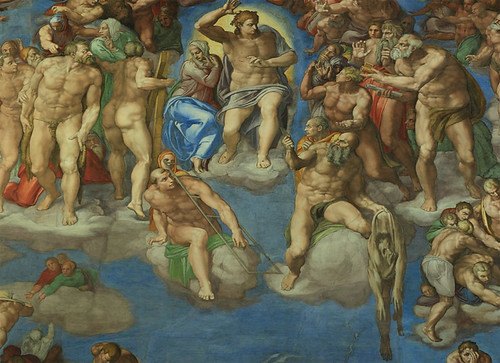






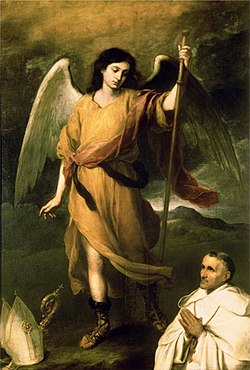









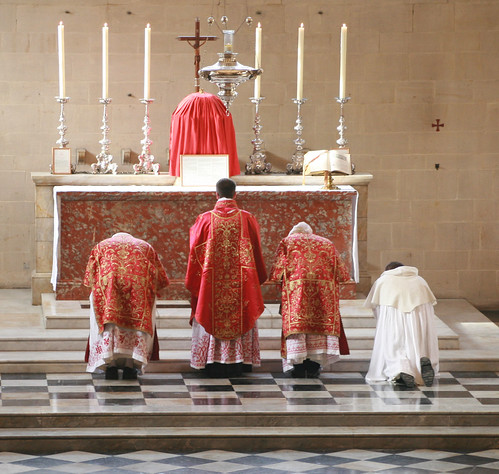





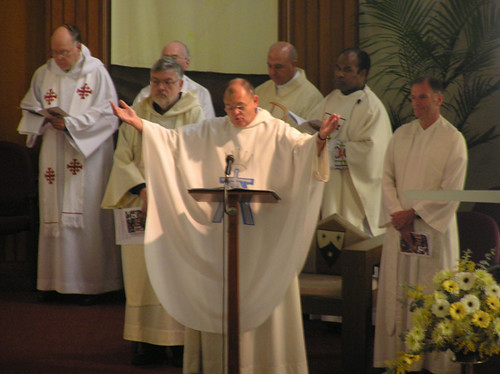

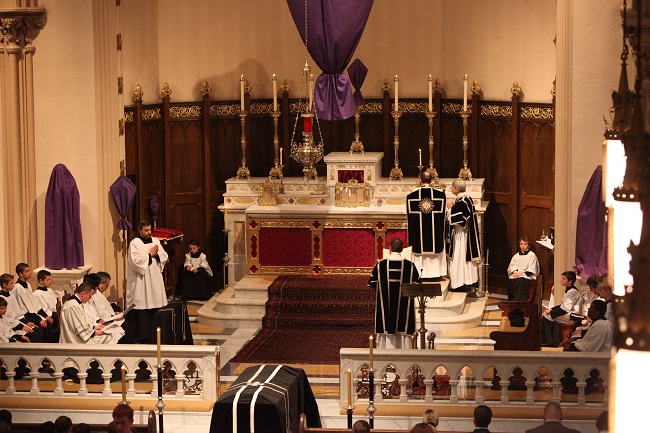

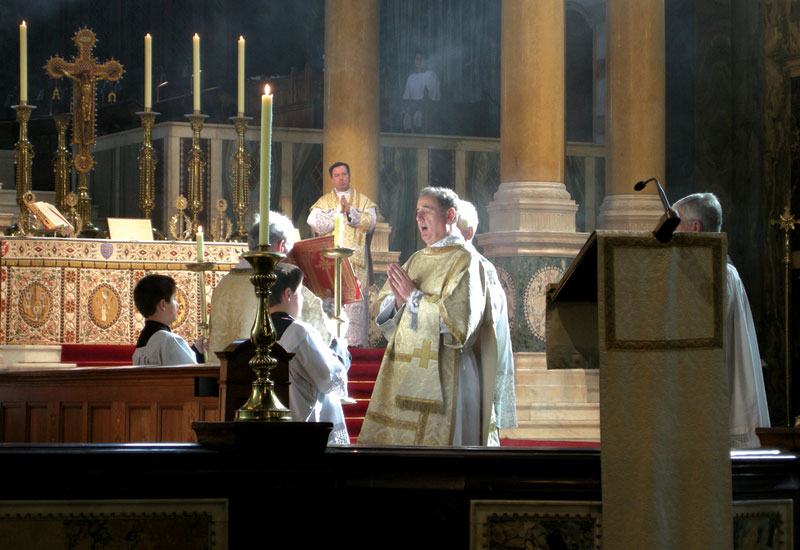



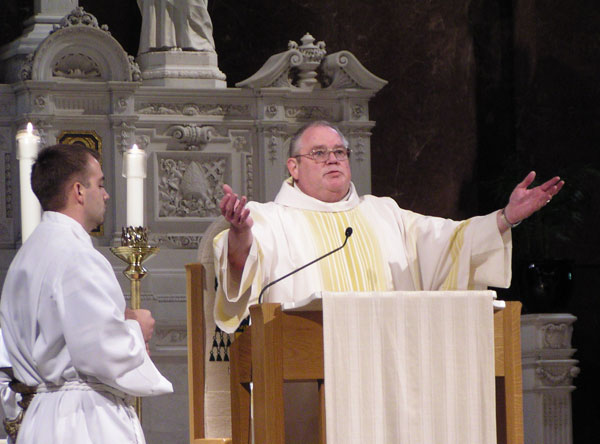


_-_James_Tissot.jpg)










